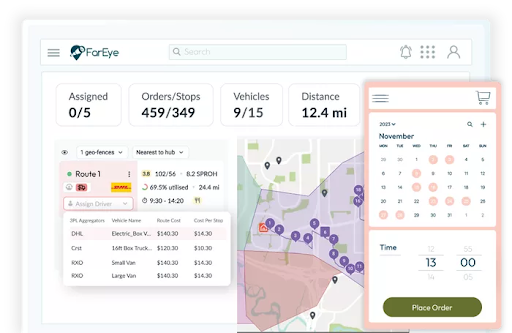- Dispatch Software
The Role of Fleet Dispatch Software in Managing Mixed Vehicle Fleets
Table of Contents
- The New Reality: Managing Mixed Fleets
- Why Traditional Dispatching Falls Short
- The Power of Fleet Dispatch Software: Turning Complexity into Control
- Routing Reimagined: The AI and Machine Learning Edge
- Essential Features for Managing Mixed Fleets
- FarEye: Leading the Way for Mixed Fleets
- Ready to Transform Your Mixed Fleet Operations?

Fleet dispatch software is the backbone for managing mixed vehicle fleets that deliver groceries, pharmaceuticals, and heavy goods reliably every day. According to a report, US trucks moved nearly 11.27 billion tons of freight, a volume that’s projected to reach 13.99 billion tons in 2035. Yet behind these numbers lies a persistent challenge: matching the right order to the right vehicle at the right time across an increasingly mixed fleet.
The pressure is felt most by dispatchers and fleet allocators, who balance daily operational demands with rising customer expectations for transparency, speed, and accuracy. Outdated manual approaches rarely keep pace. And with diverse vehicle types, light vans, heavy-duty trucks, electric delivery vehicles, and refrigerated units, any inefficiency can snowball into missed deliveries, compliance headaches, or lost revenue.
As e-commerce, on-demand services, and sustainability initiatives transform the US supply chain, the role of fleet dispatching software has become essential. The real question: how do today’s best-run logistics teams use these tools to turn complexity into an advantage?

The New Reality: Managing Mixed Fleets
Mixed fleets are now the standard for modern delivery and distribution. Companies blend trucks, vans, electric vehicles (EVs), and specialty units to meet a wide range of delivery needs: urban drops, long-haul, temperature-sensitive goods, or regulatory zones. This variety gives logistics teams flexibility, but it also multiplies operational challenges.
Assigning orders by hand or using spreadsheets is no longer practical when each vehicle type has its own limits: weight, size, emissions, charging or fueling needs, and local restrictions. Customer demands have also shifted businesses and consumers expect narrow delivery windows, live tracking, and zero surprises.
What’s needed is a single pane of glass: software that centralizes every detail, automatically pairs each job with the right vehicle, and offers real-time visibility, regardless of fleet size or composition.
Why Traditional Dispatching Falls Short
Many logistics teams still rely on manual routing, phone calls, and legacy platforms patched together over time. But as fleets diversify, these methods break down.
Consider a food distributor handling orders for both downtown restaurants and rural retailers. Some deliveries need a refrigerated van, others a fuel-efficient EV, and a handful require a box truck. Without fleet dispatching software, managing capacity, compliance, and driver hours for each job becomes a daily headache. The risk? Late or missed deliveries, frustrated drivers, and rising costs.
Legacy tools often lack the following:
- Real-time integration with telematics, sensors, and vehicle tracking
- Automated routing based on mixed vehicle profiles
- Instant visibility for dispatchers and customer service teams
- Support for batch processing and dynamic reallocation when something changes mid-route
This is where modern dispatch fleet management software is fundamentally changing the game.
The Power of Fleet Dispatch Software: Turning Complexity into Control
At the core, fleet dispatch software gives dispatchers the control and agility they need to keep goods moving efficiently, no matter how varied the fleet.
- Centralized Visibility and Real-time Data
The right platform consolidates every asset and job into a live dashboard. Whether the fleet includes light-duty EVs for last-mile drops or heavy haulers for bulk shipments, dispatchers get a clear view of vehicle locations, available capacity, driver schedules, maintenance alerts, and more.
- Smart Order-to-vehicle Matching
Intelligent software considers every relevant factor, order size, delivery window, road restrictions, load temperature, and vehicle range, and auto-assigns jobs to the best-fit vehicle and driver.
For example, a perishable order for an urban address is sent to a refrigerated van that can enter city green zones, while a high-volume delivery is routed to a box truck that can bypass highway tolls.
Use case: HVAC and appliance delivery the platform matches certified technicians and required tools to orders, preventing failed first attempts and repeat trips.
- Dynamic Routing and Rapid Response
Automated routing is the backbone of dispatch fleet management software. AI-driven algorithms evaluate live traffic, weather, vehicle-specific constraints, and delivery priorities, helping make routes faster and more cost-effective.
If a vehicle breaks down or a route is blocked, the system instantly reallocates the load, notifies the driver, and updates all stakeholders, reducing downtime and keeping deliveries on schedule.
Routing Reimagined: The AI and Machine Learning Edge
Traditional routing software relies on fixed rules and basic mapping. Modern fleet dispatching software leverages AI and machine learning for continuous improvement.
AI-powered routing tools analyze thousands of data points, historical delivery patterns, driver performance, road incidents, and even customer preferences to predict and prevent problems before they occur. Machine learning models learn from each delivery, refining ETAs, optimizing vehicle utilization, and even suggesting when to swap assets between routes.
FarEye’s solution gives logistics professionals a tangible edge:
- Predictive Route Planning: AI forecasts traffic patterns and order surges, recommending proactive adjustments.
- Automated Exception Management: Machine learning detects anomalies (such as an EV’s range dropping below normal) and reroutes automatically.
- Continuous Feedback Loop: The system gets smarter with every completed job, identifying bottlenecks and highlighting opportunities for cost savings.
For dispatchers handling hundreds or thousands of orders a day across a mixed fleet, this level of intelligence is transformative.
Essential Features for Managing Mixed Fleets
Effective fleet dispatching software brings together features that address the realities of mixed fleet management. Here’s what the best solutions deliver:
- Bulk Order Processing
Logistics teams can import and assign large batches of orders in a few clicks. The software automatically sorts, sequences, and pairs jobs to the optimal vehicles vital during e-commerce peaks or seasonal surges. - Telematics and Compliance
Integrated telematics tracks vehicle health, driver behavior, and location in real time. For mixed fleets, this means dispatchers know when an EV needs charging, a reefer unit requires maintenance, or a driver is approaching HOS limits. Automated compliance checks help avoid violations, reduce paperwork, and minimize downtime. - Seamless Communication
Dispatchers, drivers, and customer service teams stay connected through in-app messaging and alerts. If a delivery is delayed, the system sends instant notifications to everyone involved, including the customer, keeping trust high and calls to a minimum. - Integration with Enterprise Systems
Leading solutions offer plug-and-play integration with WMS, TMS, accounting, and CRM platforms. This allows for end-to-end visibility, streamlined billing, and easier data sharing, making scaling the operation less of a technical headache.
FarEye: Leading the Way for Mixed Fleets
For US logistics leaders searching for a true enterprise-grade solution, FarEye is redefining what’s possible in fleet management. The platform brings together AI-powered routing, end-to-end visibility, predictive analytics, and seamless integration, all designed for the complexity of mixed fleets.
FarEye’s transportation management solution allows dispatchers and allocators to manage orders, assign jobs, and optimize routes in real-time across every asset, driver, and region. With machine learning-driven insights, the platform turns every delivery into a data point, helping teams drive continuous improvement and future-proof their operations.
Typical enterprise rollout: 2–4 week pilot, 2–8 week integration, depending on systems and data readiness. Most customers see measurable OTIF and utilization improvements within 60–90 days.
Ready to Transform Your Mixed Fleet Operations?
Fleet dispatch software is no longer a nice to have; it’s the operational backbone for organizations running mixed vehicle fleets in the US. With order volumes rising and customer expectations higher than ever, only smart, connected, and AI-powered solutions can deliver the efficiency, agility, and visibility of modern logistics demands.
Enterprises that adopt FarEye’s intelligent tools not only gain tighter control over their fleets but also set the stage for scalable, sustainable growth, one delivery at a time. Request a demo to see how fleet dispatch software can optimize mixed fleets, reduce costs, and improve on-time rates.
Source:
https://www.trucking.org/news-insights/truck-freight-bounce-back-2025-ata-projects

Komal Puri is a seasoned professional in the logistics and supply chain industry. As the AVP of Marketing and a subject matter expert at FarEye, she has been instrumental in shaping the industry narrative for the past decade. Her expertise and insights have earned her numerous awards and recognition. Komal’s writings reflect her deep understanding of the industry, offering valuable insights and thought leadership.
Let's Talk to Our Experts and Optimize Your Deliveries Today!
An expert from our team will reach out within 24 hours
Related resources


